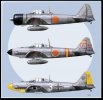Hello!

I seem to have followed a fellow forum member down a dark thread and popped up here.

My question is in regards to this attached image as created by
https://www.deviantart.com/jimbowyrick1
With a quick wiki search it seems the Mitsubishi machine was developed in the mid 1930's so it's a contemporary with the Messerschmitt 109.
It's... possible, ues? The collaboration between the two country's etc.
So, my question is more about... how would such a beast perform?
Would there be advantages over either the original Zero or the 109?
Would it have given the Lufwaffe a 'Better' machine?
Could people have sat on Prof Messerchmitt long enough to get the... hybrid... developed and produced?
Would it have been worse in regards to Spitfires punching better holes in it?
Hope my first post here is within the bounds, as it were.
Cheers.
